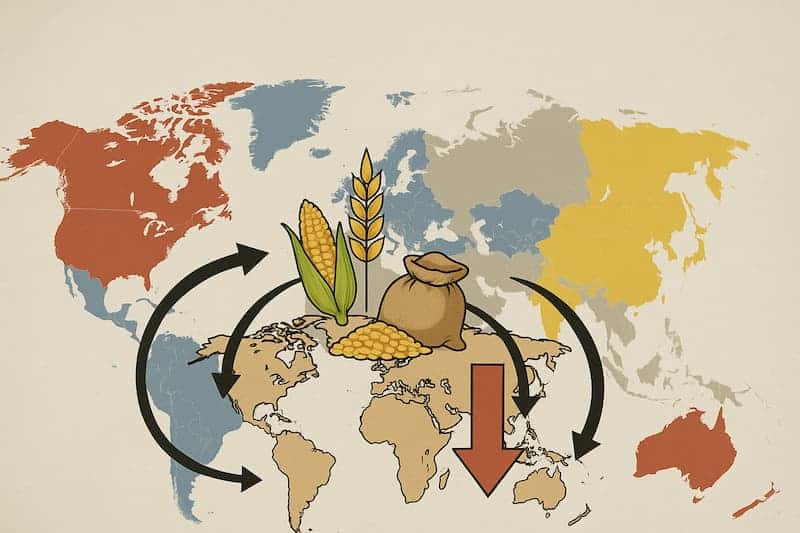The US trade wars started by focusing on countries. Here, negotiating positions are unclear, as there are many different products and complex supply chains with mutual dependencies. Here, trade wars can derail the economies of both the U.S. and the countries exporting to the U.S. But trade wars derail governments if their populations face the risk of hunger. It is therefore disturbing that Trump and Vance are now considering shifting their trade wars to target agricultural products. Agricultural supply chains are however also complex, especially over time. Climate change, demographic trends, living standards, fertilizers, and scientific research all play a role.
This blog post is part 2 of 2
Trade agreements are long term ...
Reducing U.S. imports in the short and medium term is nearly unrealistic though. First, the U.S. must be able to produce the goods it currently imports. That excludes all tropical fruits and nuts. Second, the U.S. would then have to produce the remaining goods at competitive prices to avoid triggering inflation. Building such production capacity would take many years, time is the one luxury Trump’s plan lacks. Finally, the last alternative, rationing selected imports, would negatively affect consumer sentiment. That could lead to broader backlash, including undermining his re-election chances. Trump may threaten such measures, but it is unlikely he would implement them for any extended period.
Increasing U.S. agricultural exports for one year is one thing. Securing a trade agreement that sustains that development over the next four years, and four decades, is quite another. The USMCA agreement process is a case in point.
Trade agreements are by nature long-term. Harvest yields vary year by year, especially due to weather and fertilization. But in the long term, weather patterns are increasingly shaped by climate change, which often leads to irreversible shifts in agricultural potential. The agricultural lobbying organizations are highly aware of this. Therefore, any relevant trade agreement must account for many possible futures. Otherwise, Trump risks losing the deep support from the agricultural sector that he needs.
... and thus they should account for e.g. climate change ...
Long-term trade agreements must factor in that the U.S. climate is becoming warmer, and especially more unstable.
Today, the following crops are generally suited to these climate zones:
- Tropical: High temperature and rainfall; suited for rice, sugarcane, bananas.
- Subtropical: Hot summers and mild winters; suited for soybeans, cotton, peanuts.
- Temperate: Moderate temperatures; suited for wheat, corn, potatoes.
However, crops are especially sensitive to the right balance between sunlight, heat, and rainfall, with sufficient regularity. Climate changes particularly affect the regularity.
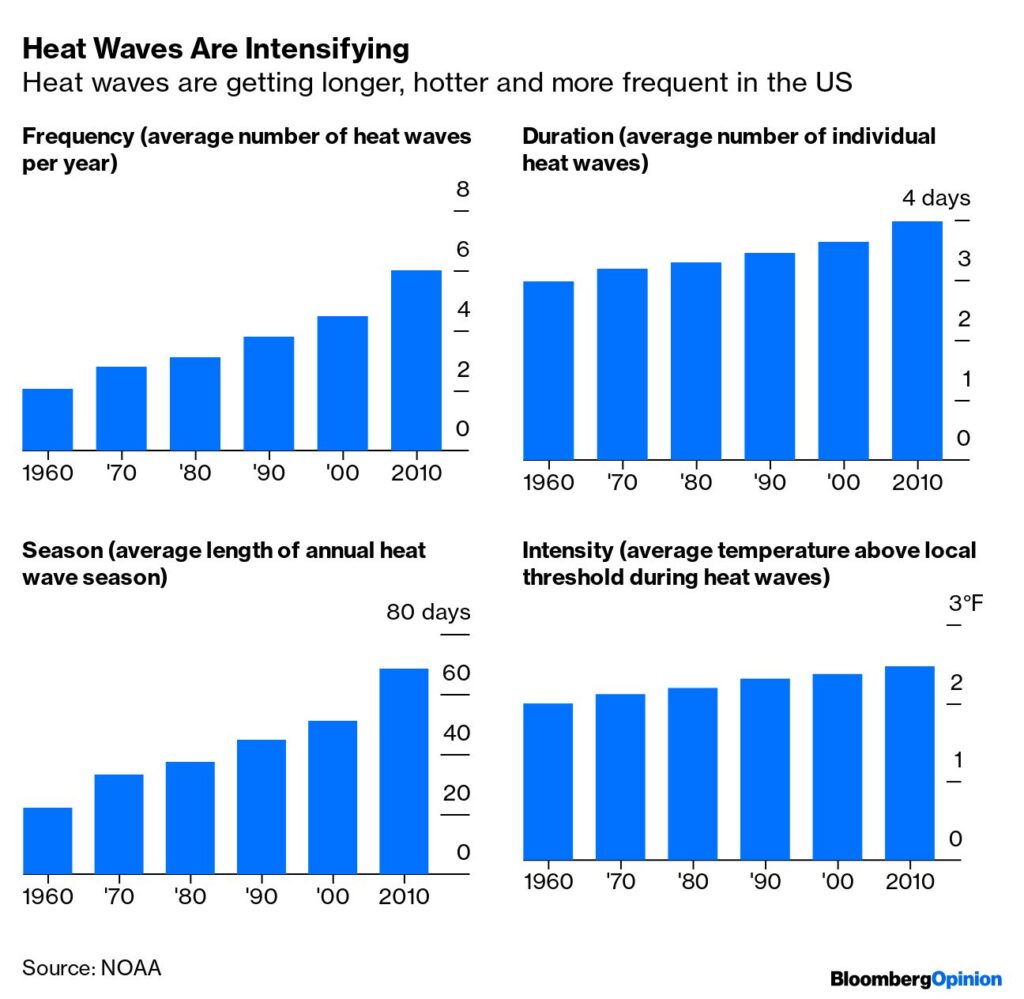
This e.g. means, that the intervals between “mega-droughts” will be shorter. The latest such ravaged the western U.S. in 2022 and a.o. caused the country’s second-largest reservoir, Lake Powell, to drop to its lowest level since it was dammed 50 years ago. This impacted the supply of both drinking water and agricultural irrigation, and simultaneously reduced hydroelectric power production in Arizona, Colorado, Nebraska, and other states.
... that affect the agricultures of both the U,S. and the rest of the world
Climate change will generally reduce agricultural output across most of the globe, including the United States. The only countries expected to see overall improvements are Canada and Russia.
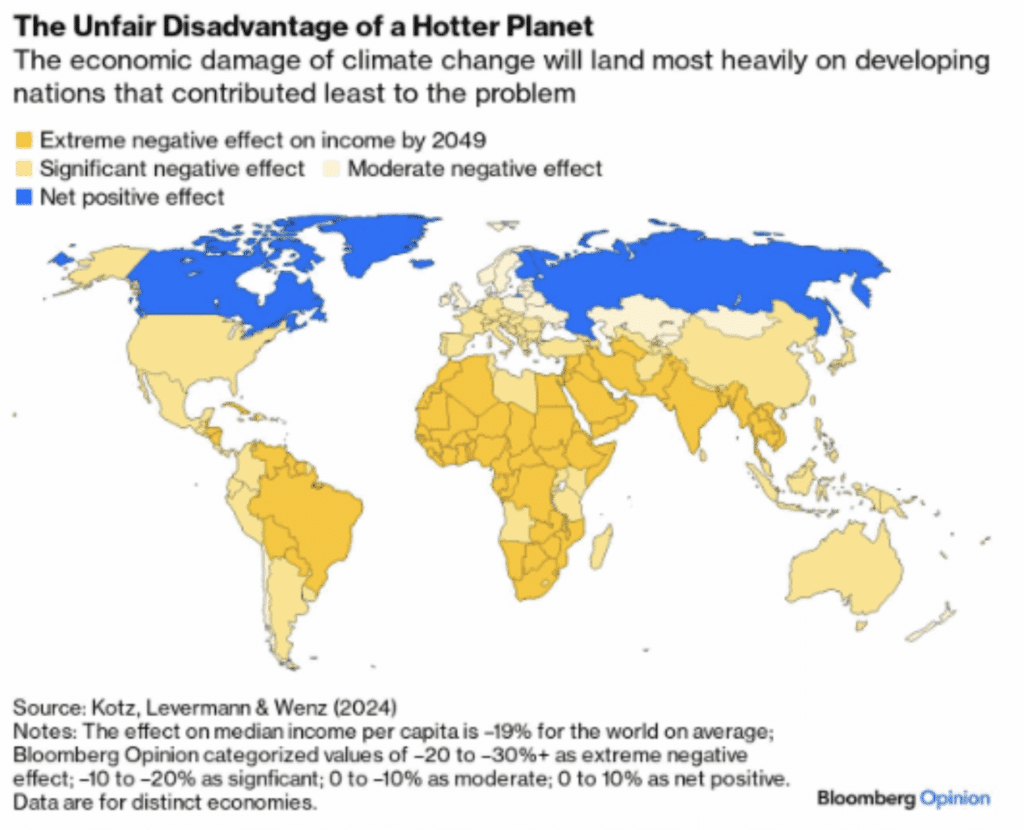
In general, crops are affected differently by climate change:
- Highly sensitive: Corn (maize), rice, soybeans, cotton.
- Moderately sensitive: Wheat, barley, canola (rapeseed).
- Low sensitivity: Cassava, sorghum, millet.
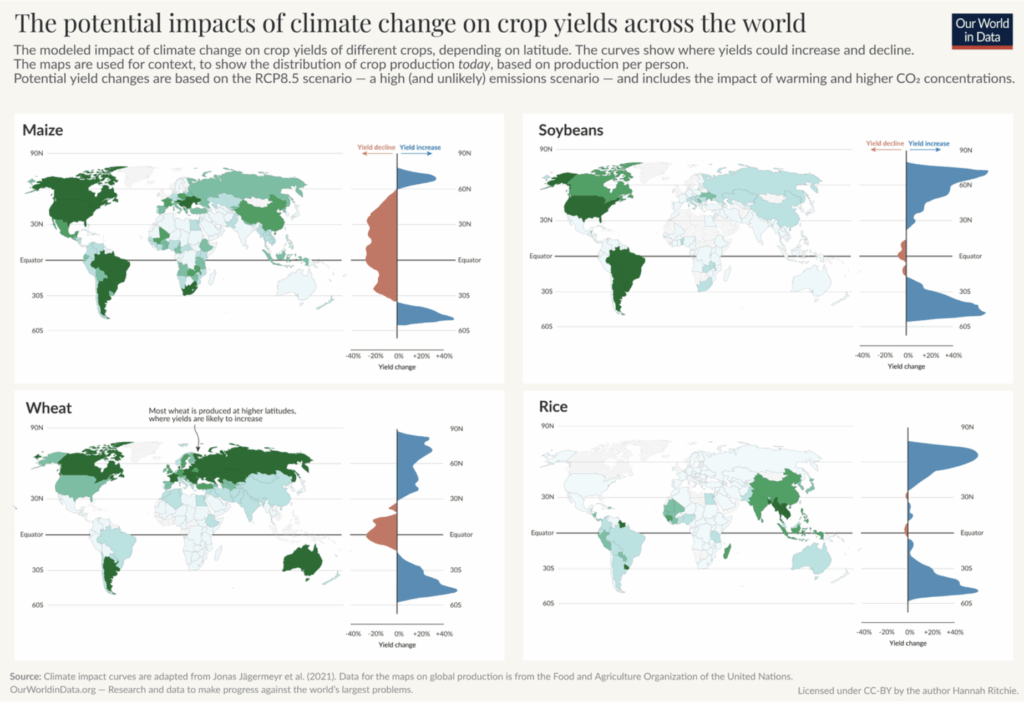
U.S. agriculture is based on crops that are highly sensitive to climate change ...
Overall, climate change thus particularly affects the agricultural products that the U.S. currently exports, namely soybeans, cotton, and corn.
Here is a more detailed breakdown:
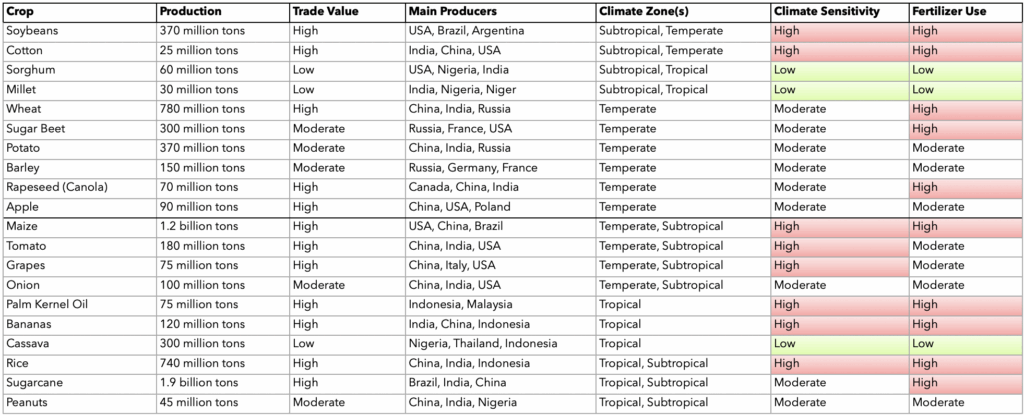
This means that U.S. agriculture is becoming increasingly dependent on breakthroughs in CRISPR research to develop more climate-resilient varieties of wheat and barley. In many regions, however, American agriculture will need to transition regardless, toward smaller and more subtropical crops. These include more climate-resilient crops such as sorghum, millet, and onions.
Trade agreements on agricultural products must also take into account fertilizer requirements, which are likewise affected by climate change. In general, the crops grown in the U.S. require large amounts of fertilizer:
- High demand: Corn, rice, soybeans, cotton.
- Moderate demand: Wheat, barley, potatoes.
- Low demand: Cassava, sorghum, millet.
This gives the U.S. a geopolitical supply chain dependency on fertilizer that must be addressed in trade agreements.
... and highly sensitive towards fertilizers
There are three main types of fertilizers used in modern agriculture:
- Nitrogen fertilizer (N-fertilizer) promotes leaf and stem growth and is often the most limiting nutrient for plant growth. Examples include ammonium nitrate, urea (carbamide), and ammonia (primarily used in industrial applications). Production requires large amounts of natural gas (Haber-Bosch process) to convert nitrogen from the air into ammonia.
- Major producers include China, the U.S., Russia, India, Qatar, Saudi Arabia, and Iran. However, any country with access to wind or solar energy can in principle produce it independently (e.g., through green ammonia via electrolysis). The most natural method remains nitrogen fixation by legumes through photosynthesis, which captures nitrogen from the air and stores it in their roots.
- Phosphorus fertilizer (P-fertilizer) supports root development, flowering, and fruiting. Phosphorus originates from fossilized bird droppings and binds quickly to soil, so it must be continuously replenished. P-fertilizer is extracted from phosphate rock and processed with sulfuric acid to make it usable.
- The U.S., China, and Russia can meet domestic demand and export small amounts, but Morocco is the global leader, controlling up to 70% of the world's reserves (via the OCP Group).
- Potassium fertilizer (K-fertilizer) improves plants’ water uptake, strengthens stalks, and increases resistance to disease. As such, climate change increases the importance of potassium. K-fertilizers are typically potassium chloride (potash) or potassium nitrate, both extracted from mineral deposits in mines.
- Canada accounts for nearly half of global potassium exports (companies Nutrien and Mosaic), followed by Russia (Uralkali), Belarus, and Germany. Potassium exists in seawater and minerals like feldspar, but is currently very energy-intensive to extract. Research is underway on using microorganisms to release potassium from silicate minerals, but there is no breakthrough yet at industrial scale.
The world’s dependence on potassium imports has long been used as a geopolitical tool. In 2022, for example, Russia threatened to cut potassium exports to India if it condemned the invasion of Ukraine.
Today, the U.S. imports 91% of its potassium consumption, almost entirely from Canada. This dependency makes it even more difficult for the U.S. to negotiate a new trade deal with Canada, especially if the agreement is supposed to increase federal revenue through tariffs.
Trade agreements are therefore also complex here.
All in all , new trade agreements must take into account the deep mutual dependencies stemming from a specialized and globalized world. This is regardless of which agreements the U.S. seeks to enter and regardless of the product categories involved. No party will be inclined to merely give, without also getting something in return.
Thus, there is a likelihood that the U.S.’s overall net import levels will remain unchanged. In some cases, however, the import mix may shift. Often, this shift will be away from areas where countries have natural competitive advantages. The longer the supply chains and the fewer the key suppliers, the more difficult and expensive such transitions become for all parties. But for that reason alone, the U.S. government’s revenues are unlikely to increase significantly, and Trump therefore does not solve the core economic issue: the budget deficit.
The cost of "decoupling" will also be high for agricultural products (as outlined above). This holds true even though most of these goods should, in principle, be fully substitutable, that is, standardized commodities much like oil.
Nothing real is as simple as the statements made by Trump and Vance. The world is deeply specialized and globalized, especially in developed nations.
The only certain may be though that EMDEs will lose no matter what
A senior UN diplomat recently noted that the only certainty is that developing countries will pay the price for the trade wars of wealthy nations. The poorer they are, the greater the relative cost they will bear. Many of these countries already face food insecurity, and their agricultural outlook is declining as a result of climate change.
- The World Food Programme, for instance, estimates that between 1 and 3 billion people will suffer from undernourishment by the year 2100 as a direct result of climate change.
- This will impact global politics, as any government unable to feed its people risks being overthrown.
The outlook for developing countries is further worsened by Trump’s drastic cuts to USAID, which has been reduced to nearly nothing. In April, this led World Bank President Ajay Banga, an Indian-American, to urge the world’s developing nations to negotiate trade deals with the U.S. as quickly as possible: “You need to negotiate trade systems with the U.S. urgently. If you wait, you’re hurting everyone.”
- Most of Trump's foreign policy actions are aligned with the recommendations in "Project 2025" a blueprint from the ultra-conservative think tank The Heritage Foundation. These include pulling the U.S. out of the WHO and COP21, as well as dismantling USAID. “Project 2025” is also as skeptical of the G7 and G20 as Trump himself has long been.
- Among the few recommendations from Project 2025 that Trump has yet to implement is the withdrawal of the U.S. from the Bretton Woods institutions, the IMF and the World Bank. These institutions have been cornerstones of U.S. global influence since World War II, including influence over which countries receive emergency aid and loans. They have had enormous and generally positive impacts on most developing nations.
- If Trump also pulls the U.S. out of the IMF and World Bank, they can in principle continue operating. Over the past five years, the EU has notably increased its contributions and guarantees to these institutions. Today, the EU, for example, funds more than 50% of International Development Assistance (IDA).
- However, the U.S.’s “exorbitant privilege” of issuing the world’s leading reserve currency would come under serious threat. This is one reason why China’s interest in the UN, IMF, and World Bank has increased in recent years.

